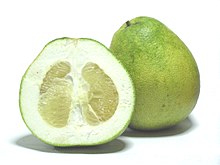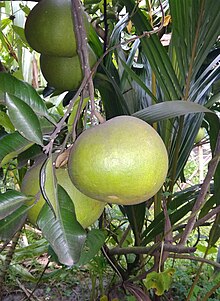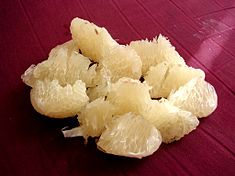Pomelo: Difference between revisions
trim Etymology, add Nutrition section |
→Drug interactions: retitle, restate; add ref details |
||
| Line 65: | Line 65: | ||
Raw pomelo flesh is 89% water, 10% [[carbohydrate]]s, 1% [[protein]], and contains negligible [[fat]] (table). A 100 gram reference amount provides 38 [[calorie]]s, and is rich in [[vitamin C]] (73% of the [[Daily Value]]), with no other [[micronutrient]]s in significant content (table). |
Raw pomelo flesh is 89% water, 10% [[carbohydrate]]s, 1% [[protein]], and contains negligible [[fat]] (table). A 100 gram reference amount provides 38 [[calorie]]s, and is rich in [[vitamin C]] (73% of the [[Daily Value]]), with no other [[micronutrient]]s in significant content (table). |
||
==Potential drug interaction== |
|||
==Drug interactions== |
|||
{{main|Grapefruit–drug interactions}} |
{{main|Grapefruit–drug interactions}} |
||
As a relative of grapefruit, pomelo may cause [[adverse effect]]s by interacting with [[prescription drug]]s, particularly those having action through [[cytochrome P450]], such as [[anti-hypertensive]]s and [[anticoagulant]]s.<ref name="Bailey">{{cite journal | last=Bailey | first=D. G. | last2=Dresser | first2=G. | last3=Arnold | first3=J. M. O. | title=Grapefruit-medication interactions: Forbidden fruit or avoidable consequences? | journal=Canadian Medical Association Journal | volume=185 | issue=4 | date=2012-11-26 | issn=0820-3946 | doi=10.1503/cmaj.120951 | pages=309–316|pmc=3589309|pmid=23184849}}</ref> |
|||
Some medicines may interact dangerously with pomelos and some pomelo hybrids, including [[grapefruit]], some limes, and [[bitter orange|some oranges]].<ref>Grapefruit–medication interactions: Forbidden fruit or avoidable consequences? CMAJ March 5, 2013 vol. 185 no. 4 First published November 26, 2012, doi: 10.1503/cmaj.120951 David G. Bailey, George Dresser, J. Malcolm O. Arnold, [http://www.cmaj.ca/content/185/4/309]</ref> |
|||
==Other uses== |
==Other uses== |
||
Revision as of 02:33, 2 February 2020
| Pomelo | |
|---|---|

| |

| |
| Scientific classification | |
| Kingdom: | Plantae |
| Clade: | Tracheophytes |
| Clade: | Angiosperms |
| Clade: | Eudicots |
| Clade: | Rosids |
| Order: | Sapindales |
| Family: | Rutaceae |
| Genus: | Citrus |
| Species: | C. maxima
|
| Binomial name | |
| Citrus maxima | |
 Flesh of a pomelo | |
| Nutritional value per 100 g (3.5 oz) | |
|---|---|
| Energy | 159 kJ (38 kcal) |
9.62 g | |
| Dietary fiber | 1 g |
0.04 g | |
0.76 g | |
| Vitamins | Quantity %DV† |
| Thiamine (B1) | 3% 0.034 mg |
| Riboflavin (B2) | 2% 0.027 mg |
| Niacin (B3) | 1% 0.22 mg |
| Vitamin B6 | 2% 0.036 mg |
| Vitamin C | 68% 61 mg |
| Minerals | Quantity %DV† |
| Iron | 1% 0.11 mg |
| Magnesium | 1% 6 mg |
| Manganese | 1% 0.017 mg |
| Phosphorus | 1% 17 mg |
| Potassium | 7% 216 mg |
| Sodium | 0% 1 mg |
| Zinc | 1% 0.08 mg |
| Other constituents | Quantity |
| Water | 89 g |
| †Percentages estimated using US recommendations for adults,[1] except for potassium, which is estimated based on expert recommendation from the National Academies.[2] | |
The pomelo, pummelo, or in scientific terms Citrus maxima or Citrus grandis, is the largest citrus fruit from the family Rutaceae.[3] It is a natural, i.e., non-hybrid, citrus fruit, similar in taste to a large grapefruit, native to South and Southeast Asia.[3] The pomelo is one of the original citrus species from which the rest of cultivated citrus have been hybridized.[3] The fruit is used in many festive celebrations throughout Southeast Asia.
Etymology

The etymology of the word "pomelo" derived from the Dutch pompelmoes, which is rendered pompelmus in German, and pamplemousse in French.[3] Its botanical name, Citrus maximus, means "big citrus". In English, the word "pomelo" (also spelled pomello, pummelo, pommelo, pumelo) has become the more common name, although "pomelo" has historically been used for grapefruit. (The 1973 printing of the American Heritage Dictionary, for example, gives grapefruit as the only meaning of "pomelo.")
After a Captain Shaddock of an East India Company ship introduced it to Barbados, the fruit was called "shaddock" in English.[4][5] From there the name spread to Jamaica in 1696.[6] It remains a common name for the fruit among English authors.[7] The fruit is also known as jabong in Hawaii and jambola in varieties of English spoken in South Asia.[3]
Description and uses
This section needs expansion with: description of plant and flowers, cultivation, culinary use and nutrition; See Talk. You can help by adding to it. (March 2017) |

Citrus maxima is usually grafted onto other citrus rootstocks, but may be grown from seed.[3] Typically, the fruit is pale green to yellow when ripe, with white (or, more rarely, pink or red) flesh, and a thick rind. It is a large citrus fruit, 15–25 centimetres (6–10 in) in diameter,[8] usually weighing 1–2 kilograms (2–4 lb). Leaf petioles are distinctly winged.
The typical pomelo is larger than a grapefruit, and has a thicker rind.[3] It tastes like a mild grapefruit (believed to be a hybrid of Citrus maxima and the orange).[3][9] The flesh has little of the common grapefruit bitterness. The enveloping membranous material around the segments is bitter, considered inedible, and usually discarded.[3] There are two varieties: a sweet kind with white flesh, and a sour kind with pinkish flesh, the latter more likely to be used as a ceremony, rather than eaten.[3]
The juice is regarded as delicious, and the rind is used to make preserves or may be candied.[3] In Brazil, the thick skin may be used for making a sweet conserve, while the spongy pith of the rind is discarded. In Sri Lanka, it is often eaten as a dessert, either raw or sprinkled with sugar. Some fatty Asian dishes use sliced pre-soaked pith to absorb the sauce and fat for eating. In large parts of Southeast Asia where pomelo is native, it is a common dessert, often eaten raw and sprinkled with, or dipped in, a salt mixture. It is eaten in salads.[3] In the Philippines, the juice is mixed with pineapple and made into a pink drink.[10]
The fruit may have been introduced to China around 100 BC.[3]
Genetic diversity
A wide variability in the physical and chemical characteristics of pomelo occurs across southern Asia.[3]
Nutrition
Raw pomelo flesh is 89% water, 10% carbohydrates, 1% protein, and contains negligible fat (table). A 100 gram reference amount provides 38 calories, and is rich in vitamin C (73% of the Daily Value), with no other micronutrients in significant content (table).
Potential drug interaction
As a relative of grapefruit, pomelo may cause adverse effects by interacting with prescription drugs, particularly those having action through cytochrome P450, such as anti-hypertensives and anticoagulants.[11]
Other uses
Pomelo leaves are used for aromatic baths. The essential oil can be extracted from the leaves, peel or seeds of some pomelo species. Oil from the seeds of an inferior pomelo species was used to light opium pipes in Indochina. Perfumes are extracted from the flowers using enfleurage. The moderately heavy and hard timber from pomelo trees can be used to make, among other things, tool handles.
Varieties
Non-hybrid pomelos
Possible non-hybrid pomelos
Hybrids
The pomelo is one of the original citrus species from which the rest of cultivated citrus have been hybridized, (others being citron, mandarin, and to a lesser extent, papedas and kumquat). In particular, the common orange and the grapefruit are presumed to be naturally occurring hybrids between the pomelo and the mandarin, with the pomelo providing the larger size and greater firmness.
The pomelo is employed today in artificial breeding programs:
- The common sweet orange (Citrus × sinensis) is a pomelo × mandarin hybrid
- The bitter orange (Citrus × aurantium) is another pomelo × mandarin hybrid
- The tangelo is any hybrid between Citrus maxima and a tangerine, it generally has a thicker skin than a tangerine and is less sweet
- 'K–Early' ('Sunrise Tangelo')[12]
- Grapefruit is a pomelo backcross: pomelo × sweet orange (see above) and the grapefruit is a parent to many hybrids:
- 'Minneola': Bowen grapefruit × Dancy tangerine[12]
- 'Orlando' (formerly Take'): Bowen grapefruit × Dancy tangerine(pollen parent)[12]
- 'Nova': Clementine × Orlando tangelo cross[12]
- 'Seminole': Bowen grapefruit × Dancy tangerine[12]
- 'Thornton': tangerine × grapefruit, unspecified[12]
- 'Ugli': mandarine × grapefruit, probable (wild seedling)[12]
- The Oroblanco and Melogold grapefruits are hybrids between Citrus maxima and the grapefruit
- Mandelos: pomelo × mandarine (Citrus maxima)
- Hyuganatsu is a pomelo hybrid
Gallery
-
This white hybrid Pomelo is cushioned with a thick mesocarp layer
-
Pomelos
-
Pomelo after being cut
-
Pink pomelo juice vesicles
-
Cluster of flower buds
-
Pomelo blossom
-
Pomelo flowers in early April
-
Pomelo on tree, has fruit and blossoms at the same time
-
Fujian's Pinghe County is famous in China for its pomelos
-
Pomelo orchard
-
Pink pomelo
-
Pomelo in southern Vietnam
-
Pomelo seedling
-
Ipoh pomelos on sale at Chinatown, Singapore
-
Tam som-o nam pu: spicy Thai pomelo salad with crab extract
References
- ^ United States Food and Drug Administration (2024). "Daily Value on the Nutrition and Supplement Facts Labels". Retrieved 2024-03-28.
- ^ National Academies of Sciences, Engineering, and Medicine; Health and Medicine Division; Food and Nutrition Board; Committee to Review the Dietary Reference Intakes for Sodium and Potassium (2019). Oria, Maria; Harrison, Meghan; Stallings, Virginia A. (eds.). Dietary Reference Intakes for Sodium and Potassium. The National Academies Collection: Reports funded by National Institutes of Health. Washington, DC: National Academies Press (US). ISBN 978-0-309-48834-1. PMID 30844154.
- ^ a b c d e f g h i j k l m n Julia F Morton (1987). "Pummelo: Citrus maxima; p. 147-151. In: Fruits of warm climates". NewCROP, New Crop Resource Online Program, Center for New Crops and Plant Products, Purdue University. Retrieved 31 January 2020.
- ^ Pomelo (Pummelo) Citrus maxima
- ^ fruitInfo-trdLevel2021.html
- ^ American Heritage Dictionary, 1973.
- ^ "Shaddock". Britannica Online. Encyclopædia Britannica, Inc. Retrieved 1 January 2017.
- ^ Pomelo: Growing the granddaddy of grapefruit, SFGate.com, December 25, 2004
- ^ Julia F Morton (1987). "Grapefruit: Citrus paradisi; p. 152–158. In: Fruits of warm climates". NewCROP, New Crop Resource Online Program, Center for New Crops and Plant Products, Purdue University. Retrieved 31 January 2020.
- ^ Hargreaves, Dorothy; Hargreaves, Bob (1970). Tropical Trees of the Pacific. Kailua, Hawaii: Hargreaves. p. 51.
- ^ Bailey, D. G.; Dresser, G.; Arnold, J. M. O. (2012-11-26). "Grapefruit-medication interactions: Forbidden fruit or avoidable consequences?". Canadian Medical Association Journal. 185 (4): 309–316. doi:10.1503/cmaj.120951. ISSN 0820-3946. PMC 3589309. PMID 23184849.
- ^ a b c d e f g Morton, J. 1987. Tangelo. p. 158–160. In: Fruits of warm climates. Julia F. Morton, Miami, FL. http://www.hort.purdue.edu/newcrop/morton/tangelo.html















